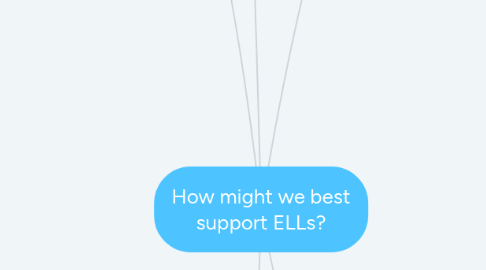
1. Dilemmas
1.1. Individual Needs
1.1.1. Having only one teacher and a classroom with numerous students who all have different needs and various entry points
1.2. Students may not want to learn English
1.3. Language Barriers
1.3.1. Lack of vocabulary to express their needs
1.4. Over Dependence on Teachers or peers for assistance
1.5. Social Challenges
1.5.1. ELL students struggling to interact with peers, and therefore lack social supports
1.6. Lack of Time
1.6.1. Teachers may not have enough time to work with ELL student thoroughly
1.7. Differentiation
1.7.1. Lack of resources
1.7.2. Lack of understanding
1.7.3. Various students to help meet their needs
2. Multiple Stakeholders
2.1. Parents
2.1.1. Native English-speaking
2.1.2. Non-native English-speaking
2.2. Students
2.2.1. ELL Students
2.2.1.1. Social Factors
2.2.1.2. Language Barriers
2.2.1.3. Isolation
2.2.1.4. Cultural Variance
2.2.2. Non ELL Students
2.3. Government
2.3.1. Federal
2.3.2. Provincial
2.3.2.1. Budget
2.4. Post-secondary Establishments
2.4.1. Requires students to have certain English proficiency
2.5. Community
2.5.1. Stereotypes
2.5.2. Not willing to support immigrant community
2.5.3. Typically monolingual
2.6. Principals
2.6.1. High expectations for teachers to differentiate well for each student
2.6.2. Accountability
2.6.2.1. Rates of graduation
2.6.3. Ensure that parents are content with quality of instruction
2.7. Teachers
2.7.1. Teacher Misconceptions
2.7.1.1. ELLs should be able to acquire English quickly
2.7.1.2. ELLs should avoid using their native language in order to acquire English
2.7.1.3. Exposure and interaction will result in English language learning
2.7.1.4. The younger the child, the greater facility in acquiring English
2.7.2. Low expectations of students of colour
2.7.2.1. Generally perceived as low achievers
2.7.2.1.1. Given lower-level tasks in comparison to their English speaking peers
2.7.2.1.2. This beliefs are passed on to students
2.7.2.1.3. Internalize the negative message and become a self-fulling prophecy
2.8. Educational Assistants
2.8.1. Lack of resources
2.8.2. Work one on one with ELL students
3. Unfamiliar Domains
3.1. Language
3.2. Funding
3.3. Resources
3.3.1. Early literacy programs available
3.4. Cultural Differences
4. Societal Challenges
4.1. Limited learning environments
4.2. One teacher for multiple students from different backgrounds, different languages and varying academic levels
4.3. Increasing immigration rate
4.4. ELLs are often considered problematic, due to their cultural and linguistic diversity (Hang Khong & Saito, 2013)
4.4.1. Social problems and isolation from community
4.4.2. Academic Struggles
4.4.3. Feelings of Hostility
4.5. Language skills over academic success
4.6. Language ability taken as signifier of intelligence
4.6.1. Job applications may impacted
4.6.2. Post-secondary admissions
4.7. Socio-economic status
4.7.1. Level of education
4.7.2. Economic situation
4.7.3. Social security
4.8. Location
4.8.1. Where students live
4.8.2. Where students go to school
4.8.3. Ethnically/Culturally diverse, or not
4.9. Lack of Teacher Preparedness
4.10. Society's negative and stereotypical view of immigrants
5. Ethical Issue
5.1. Parents unable to speak English
5.1.1. Students with English-speaking parents have an advantage
5.1.2. Students may feel a disconnect from their school and personal life
5.2. Parents unwilling to learn English
5.2.1. Rely on students to be their means of communication
5.2.2. Believe that if they learn English, their native language would be lost
5.2.3. Do not have the means/environment to learn English
5.3. Cannot force someone to learn
5.3.1. The students need to be willing to learn the language
5.3.2. For a lot of them, they do not have a choice in the matter
5.3.3. Try to take control of their own lives by refusing to learn a new language or fit into a new culture
5.4. Cannot limit the use of students' native language (assimilation)
5.4.1. It could be the only way they are able to effectively communicate
5.4.2. This is not honouring the child and the cultural background
5.4.3. This is not teaching to the needs of the student, but to the outcomes
5.5. Need to be able to communicate in new environment vs. becoming detrimental to students' mental health
5.5.1. Could overwhelm students with too much change all at once
5.5.2. They could need more time to adjust
5.5.3. Caring about outcomes vs. the well-being of the student
5.5.3.1. Against the purpose of education
5.5.3.2. Against what a good teacher should prioritize
5.6. Being out-performed by English-speaking peers which increases drop-out
5.6.1. Immense pressure on teachers to meet requirements of accountability imposed by federal guidelines
5.6.2. Increase the socio-economic gap between the dominant culture and immigrants
